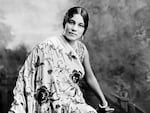
Beatrice Morrow Cannady
Oregon Historical Society
The following essay was written by Kimberley Mangun, assistant professor of communication at the University of Utah. Mangun is working on a biography about Beatrice Morrow Cannady.
In 1929, Beatrice Morrow Cannady (1889-1974) was nominated for the Harmon Foundation's annual award for Distinguished Achievement Among Negroes in the field of race relations. She had stiff competition for the national prize: Tuskegee Institute President Dr. Robert R. Moton, NAACP co-founder Mary White Ovington and journalist Delilah Beasley were among the nominees in that category. But that didn't faze Cannady's supporters, who called her an "outstanding citizen," a "figure of consequence" and a "leader among the people of her race." Despite such accolades from her peers, few Oregonians today remember this civil rights worker.
Yet during her 25-year career, Cannady published The Advocate, a weekly newspaper for African Americans; gave hundreds of lectures to white high school and college students; spoke to missionary societies and Portland congregations; was invited to address national audiences about her civil rights efforts, and discussed Negro history and literature on KGW, KOIN and other radio stations.
Cannady also hosted successful interracial tea parties at her home in northeast Portland. The Sunday-afternoon events combined entertainment, culture and history with local, national and international politics in an effort "to iron out ... misunderstandings between the races." The gatherings grew in popularity, and as many as 200 people filled her home. "It is a picture never to be forgotten," Cannady wrote, "for its great beauty and the joy it affords to witness one of these gatherings where white and black, rich and poor, Christian and Jew mingle freely and discuss their common interests while sipping together a cup of tea!"
Cannady's efforts to improve interracial relations in Portland between 1912 and 1936 were a critical component of her ongoing campaign to secure equal rights for the city's 1,500 African Americans. By the early 1900s, color lines had hardened in Portland, and discrimination was commonplace in restaurants and other public venues. Whites-only signs were displayed prominently in most downtown eateries. Cannady's son, George, was refused admission to a skating rink when he tried to attend a graduation party with his white classmates.
And in 1928, Cannady wrote in The Advocate about the humiliation she and her sons experienced at the Oriental Theatre when an usher tried to seat them in the balcony rather than on the main floor, which was reserved for white patrons. After pointing out that she was "a law-abiding citizen" who had purchased tickets for herself and her sons, she informed the usher that she preferred to sit downstairs and would do so regardless of social mores.
Cannady's message to her white audiences was clear: "As citizens, colored people deserve all the rights and privileges and the protection as any other citizen has." But external forces beyond her control - such as the arrival of the Ku Klux Klan in the spring of 1921 and repeated showings of the racist film The Birth of a Nation after its nationwide release in 1915 - made her civil rights campaign all the more challenging.
Driven to make a difference in her community, Cannady earned a law degree from Portland's Northwestern College of Law in 1922. Although she never passed the bar exam, she was the first African-American woman to practice law in Oregon and chaired the Portland NAACP's committee on legal redress. She sent a petition asking Governor Ben W. Olcott to prohibit the Klan from forming in Portland; another requested that Mayor George Baker ban The Birth of a Nation from playing at the city's theaters. While the officials were sympathetic to her pleas, they failed to take action. Cannady was forced to redouble her efforts to educate white people about the Klan's racist agenda as well as the film's effect on race relations in the city.
In April 1932, Cannady decided to try to effect reform from the capital. When she announced her candidacy for state representative from Multnomah County's fifth district, Cannady became the first African American to run for an elected office in Oregon. Although she did not advance past the primary, she garnered some 8,000 votes cast primarily by white constituents. The tally is both impressive and proof of her standing in Portland by the 1930s.
A few years later, however, Cannady decided to leave Portland and relocate to the Los Angeles area to be closer to family. She spent the next four decades there, still pursuing the things she was passionate about, but in a far less public way. Her death in 1974 at the age of 85 went unremarked in Portland, and her career remains largely forgotten. But that may be changing soon with the development of the Walk of Heroines. Cannady is one of the women whose accomplishments will be acknowledged in the public space adjacent to Portland State University and the South Park Blocks. It is a fitting location, since Cannady gave free public lectures about African-American art, poetry, history and music at nearby churches. Seventy years after she left Portland, Cannady may at last be restored to her rightful place in Northwest history.
Further Reading
African American Women Confront the West, 1600-2000; University of Oklahoma Press, 2003; Edited by Quintard Taylor, Shirley Ann Wilson Moore.
"The (Oregon) Advocate: Boosting the Race and Portland, Too." Kimberley Mangun, American Journalism 23, no. 1 (Winter 2006): 7-34.
"As citizens of Portland we must protest": Beatrice Morrow Cannady and the African American Response to D.W. Griffith's Masterpiece." Kimberley Mangun, Oregon Historical Quarterly 107, no. 3 (Fall 2006): 382-409.
Cornerstones of Community: Buildings of Portland's African American History; Portland, OR; Bosco-Milligan Foundation, 1995.
"A Force for Change: Beatrice Morrow Cannady's Program for Race Relations in Oregon, 1912-1936." Kimberley Mangun, Pacific Northwest Quarterly 96, no. 2 (Spring 2005): 69-75.
Broadcast Date: May 14, 2007